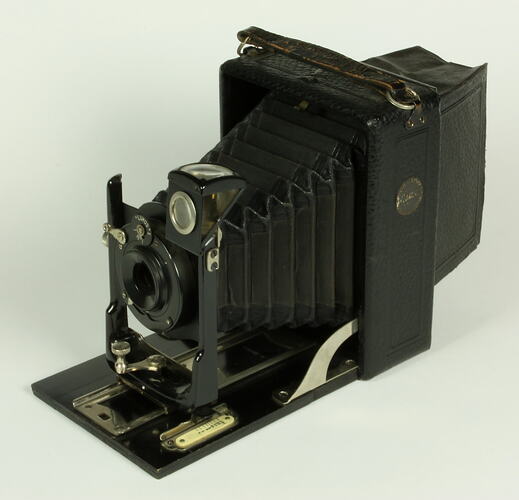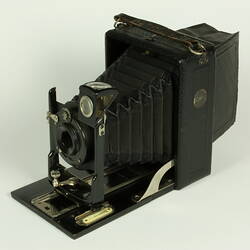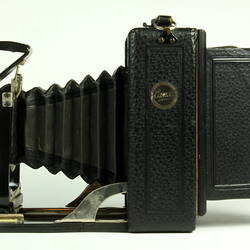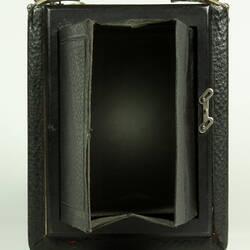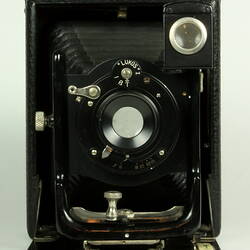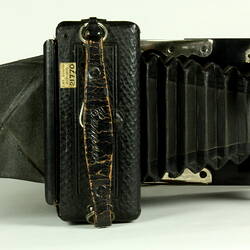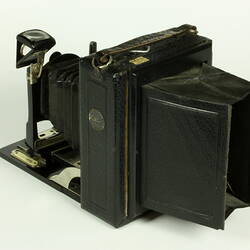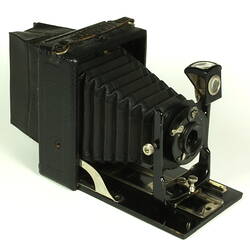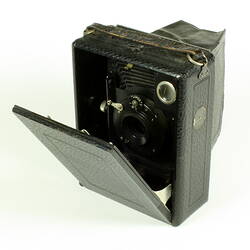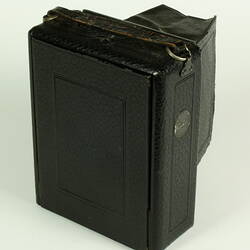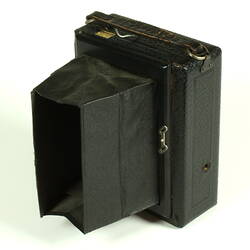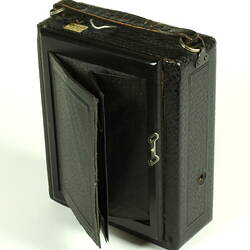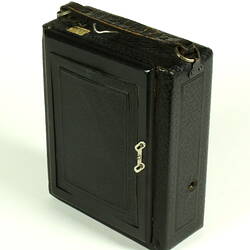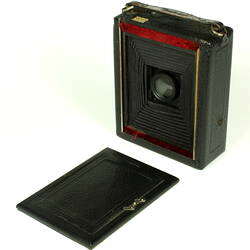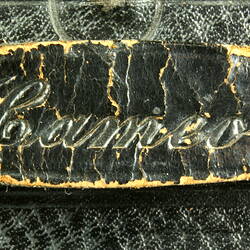Summary
'Cameo' quarter plate folding bellows pocket camera, circa 1905-1915. It was sold through J. W. Small & Co., of Melbourne, Australia.
It features a meniscus achromatic lens, engraved focusing scale (probably made of ivory), ground glass focusing screen and rising front. Fitted with two-position diagonal mirror view finder and "Lukos" I shutter mechanism, giving time, bulb and instantaneous exposures, cable and trigger release. Designed for 3¼ inch x 4? inch (82 mm x 107 mm) glass plates or sheet film.
The design appears to be similar to the German-built 'Cameo' folding camera sold by W. Butcher & Sons, of London, from about 1910-1915, that was very popular with amateur photographers. When supply of these cameras was cut off by World War I, similar designs were manufactured in Britain by The Houghton-Butcher Manufacturing Co. Ltd.
The photographic supply business of Messrs J.W. Small & Co., Little Collins Street, Melbourne, was established in 1860 and by 1897 had been taken over by Herbert Small, although it continued to trade under the name 'J.W. Small & Co.' until at least 1915. During the late 1890s the firm had been an agent for "Kodak" cameras and photographic products.
This camera is believed to have previously been owned by Francis West Chambers (1861-1928), who from 1909 held the position of electrical inspector for the Public Works Department of Victoria, with responsibility for supervising municipal power supply undertakings, and later held a similar role with the State Electricity Commission of Victoria from 1921. During the early 1900s he had collaborated with Henry Walter Jenvey in the first experimental wireless telegraphy experiments in Australia.
Physical Description
The camera has a polished ebonised baseboard and nickel fittings, covered in Morocco-grained leatherette. Black leather bellows. Black enamelled brass lens panel. 'Real brilliant' reversible view finder, which can be rotated through 90 degrees and locked into two fixed positions by a retaining spring, for either portrait or landscape format photographs.Patent infinity catch for fixing camera for snapshot work. Single metal slides. Focused by sliding the lens in or out, adjusting the lens position pointer against a graduated scale, or be viewing through the back ground glass screen. The back plate with viewing screen slides off the camera body and has a rectangular fold-out light shade.
More Information
-
Collecting Areas
-
Acquisition Information
Donation from Mr E. W. Chambers, 09 Oct 1942
-
Distributor
Central Photographic Stores, J.W. Small & Co, Equitable Buildings, 270 Little Collins Street, Melbourne, Greater Melbourne, Victoria, Australia, circa 1905-1915
It is unclear whether the camera was made by J.W. Small or imported. -
Past Owner (Probable)
Mr Francis W. Chambers, Mount Eagle, Heidelberg, Greater Melbourne, Victoria, Australia, circa 1910-1928
-
Inscriptions
Impressed 'Cameo' in italic script on leather carry handle, A small circular plate fixed to the left hand side of the body reads: 'J.W. SMALL / "Cameo" / AUSTRALIA'.
-
Brand Names
-
Classification
-
Category
-
Discipline
-
Type of item
-
Overall Dimensions - Folded
150 mm (Length), 115 mm (Width), 55 mm (Height)
Dimensions when closed for carrying. Includes leather carry scrap in its non-extended position. Camera body only is 142 x 150 x 49 mm.
-
Overall Dimensions - Unfolded
185 mm (Length), 115 mm (Width), 150 mm (Height)
Dimensions when opened for use with bellows extended. Shade hood on back focusing screen adds another 75 mm to overall length when it is fully extended.
-
Other Dimensions
131 mm (Length), 94 mm (Width), 7 mm (Depth)
Dimensions of removable backplate.
-
Keywords
Cameras, Folding Cameras, Photographic Dry Plates, Pocket Cameras
